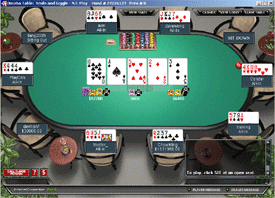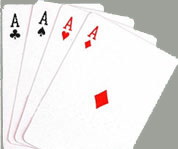|
Omaha is very similar to to Hold'em, but has a greater chance
of making bigger hands and provides for some extremely exciting
games.
|
 |
Sequence
of Events
 |

| 1. Blinds Two (2) players left of the dealer button
both post blinds equal to exactly half the limit they
are playing. These are similar to the blinds in
Hold'em). |
|
| 2. Dealer Button. This button is used to determine
where the action starts, once the game begins this
buttons moves one person to the right (clockwise) for
every new deal. |
|
| 3. Dealer deals each player four (4) cards face down (Pocket
or Hole Cards). |
|
| 4. The player to the left of the dealer now
begins the betting for this round. Each player has the
option to Call the blinds, Raise the blinds or Fold. |
|
| 5. After the first round of betting the Flop
is dealt. The Flop is three (3) community cards for
which all players may combine to make their best
possible hand. |
|
| 6. Following the Flop, the player to the left
of the button may now begin the second round of betting. |
|
| 7. Dealer turns over 1 more community card (the
turn) . |
|
| 8. Following the Turn, the third round of
betting begins. |
|
| 9. Dealer turns over 1 last community card (the
river). |
|
| 10. At this point there will be 5 community
cards of which you will make your best 5-card poker
hand. You must make the best hand using the combination
of 2 of your 4 pocket cards and 3 of the 5 community
cards. |
|
| 11. Following the river card, the final round
of betting will begin, this is the players' last
chance to bet before the cards are revealed and a winner
is determined, this is known as the showdown. |
|
| 12. Showdown. The Showdown is where players
reveal their hands to produce the winner. The winner is
determined by who has the best hand with the combination
of 2 pocket cards and 3 community cards. Player
must us only two (2) hole cards and three (3) common
cards. |
|
Betting
 |
 Each bet and
raise during the first 2 rounds is at the lower limit of the stakes
structure, e.g. $4 in a $4/$8 game. Each bet and
raise during the first 2 rounds is at the lower limit of the stakes
structure, e.g. $4 in a $4/$8 game.
Each bet and raise during the last 2 rounds is at the higher limit of
the stakes structure, e.g. $8 in a $4/$8 game.
A player can bet up to 4 times per round. This is known as a bet and
Three (3) Raises. This would consist of (1) a bet, (2) a raise, (3) a
re-raise, and (4) a cap. It's called a cap since betting is then capped
and cannot be raised anymore. Once the pot is capped, players can only
call the Cap or fold.
Check-raising is allowed in all games.
Button
and Blinds
 |
 Omaha Hi and
Omaha Hi/Lo use a button to indicate the theoretical
dealer of each hand. Omaha Hi and
Omaha Hi/Lo use a button to indicate the theoretical
dealer of each hand.
After each hand, the button moves clockwise to the next active
player. The player to the left of the button is first to receive a card
and must post a small blind. The small blind is half
the lower limit bet, rounded down to the nearest dollar. The player to
the left of the small blind must post the big blind,
equal to the lower limit bet. Example: in a $4-$8 game the blinds would
be Small Blind $2.00 and Big Blind $4.00. This replaces the antes in
7-card stud.
Both blinds are immediately in the hand and have options when in
clockwise progression the action returns to them. For the Small Blind
those options are to call the remainder of any bets made, or to raise if
there are still raises remaining (not yet capped).
For the Big Blind those options are to check if no one has raised, to
call if someone has raised or to raise if there are still raises
remaining (not yet capped). After the flop and each subsequent betting
round, the first active player left of the button is first to act.
When a player first sits at an active table, they may post the
equivalent of the big blind. To play immediately all players may sit out
and wait to become the actual big blind before playing. This rule
ensures fairness to all players and stops potential abuses by preventing
players from constantly entering games in late position and then leaving
before they're required to post the big blind.
Hand
Rankings
 |
 Rankings
follow in descending order. Rankings
follow in descending order.
If multiple hands match in rank, the winner is the one with higher
cards, e.g., a Queen-high straight beats a 9-high straight.
If the hands are still tied, the kicker determines
the winner on hands that are 3 of a kind or below. If the hands remain
tied, the pot is split between the winners. Any odd chips go to the left
of the button.

1. Royal Flush
|

2. Straight Flush
|

3. 4-of-a-kind
|

4. Full House
|

5. Flush
|

6. Straight
|

7. 3-of-a-kind
|

8. 2 Pair
|

9. 1 Pair
|
|

10. High Card
|
|
All decisions made by Poker-Flush regarding the ranking of hands are
FINAL
All-Ins
 |
 Online poker
games are played at "Table Stakes". This means that only the
chip value you have in front of you at the start of a given hand can be
used in that hand. You can increase your "table stake" at any
time in between hands; NEVER DURING A HAND. Online poker
games are played at "Table Stakes". This means that only the
chip value you have in front of you at the start of a given hand can be
used in that hand. You can increase your "table stake" at any
time in between hands; NEVER DURING A HAND.
Sometimes during the course of a hand the betting will exceed a
players "stake" and the player may not have enough to call a
particular bet. The player does not have to forfeit their hand at this
point. Should the player wish to continue, they can call the amount that
they have in front of them and they will be declared "ALL IN".
Any further action will create a side pot of which the "All
In" player will have no claim to. The limit of the number of side
pots is only limited to the number of participants in a particular hand.
The player will have claim to the portion of the pot that they have
contributed to. This rule is exactly how it's handled in Brick and
Mortar card rooms.
Different from a B & M card room is the "ALL In" rule
that occurs during Internet disconnects.
Our software can determine whether you are disconnected from the
Internet during a hand. Should this occur your hand would play and lay
claim to the portion of the pot that you have contributed to, up to and
until the disconnection occurred.
You will notice in the game that you have a preset "all in"
account. This account has in it TWO (2) all ins allowed in a 24 hour
period. Should this happen more than twice in a 24 hour period, you can
ask to have this account reset by e-mailing support and requesting an
all in re-set. Should this become a regular occurrence, please e-mail
support to find out what suggestions we might have to help you increase
the reliability of your connection.
If we determine that you are connected to the game your hand will be
folded. This is done to protect the integrity of the game. Further if we
feel that the "All In" policy is being abused, the abusing
will be addressed and "All In" privileges may be revoked.
Players should exercise caution when both "All Ins" have
been used. Until your account of "all ins" has been reset,
your hand may be folded during a disconnection and you can lay no claim
to the hand or the pot you were involved with immediately prior to the
disconnection.
Buy-Ins
 |
 The Minimum
Buy-in requirement for all games is 10 times the Small Blind/Bet in the
Game. The Minimum
Buy-in requirement for all games is 10 times the Small Blind/Bet in the
Game.
Examples:
Buy in examples would be $100 to enter the $10/$20 game, $50 to enter
the $5/$10 game, $30 to enter the $3/$6 game or $5.00 to enter a 50¢/$1.00
game
Omaha
Hi/Lo
The difference between Omaha Hi and Omaha Hi/Lo is that in Hi/Lo, the
pot is split 50-50 between the person with the best hand and the person
with the worst qualifying low hand. Omaha Hi/Lo is difficult and
requires skill and a little practice in order to understand.
The structure of Omaha Hi/Lo is exactly the same as that of Omaha Hi,
except the pot is split 50% to the person with the highest hand and 50%
to the person with the lowest qualifying hand.
A low hand must be an "8 or less" in order to qualify. The low
hand is determined by the person with the lowest high card. In the event
of a tie the pot goes to the person with the next lowest high card.
Example a one person has a low card hand of 8 5
5 4
4 3
3 2
2 and the other person has 8
and the other person has 8 6
6 5
5 3
3 2
2 .
Both of these players qualify for the low card hand, the winner is
determined typically by the lowest high card, however both people here
have 8s, so the next highest low card is used to determine the winner.
In this case the first player has the lowest high card of a 5 .
Both of these players qualify for the low card hand, the winner is
determined typically by the lowest high card, however both people here
have 8s, so the next highest low card is used to determine the winner.
In this case the first player has the lowest high card of a 5 so therefore they are the winner.
so therefore they are the winner.
Any hand that is high card 9 or higher can NOT qualify as a Low Hand.
If there is no qualifying low hand then the high hand wins 100% of
the pot.
- At the show down two cards can be used for the High Hand or
players can use a combination of two cards for the Low Hand.
- A, 2, 3, 4, 5 is the best low hand. This will also count as a
straight for high. Aces can be used for both high and low.
- Straights and flushes are not considered when evaluating a low
hand.
- A player can "scoop" the entire pot with both the high
and low having the combination of both the highest and lowest hands.
|
